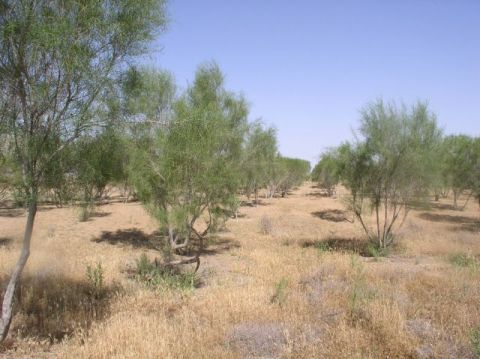Runoff Agriculture in Turkmenistan
Turkmenistan – a former Soviet Union republic on the northeast border of Iran – is located in the Aral Sea Basin, with the Kara Kum Desert covering more than 80% of its area. Because the country experiences an average annual rainfall of 140 mm., water for agricultural activity must supplied through a 1300 km.-long canal leading from the Amu Darya River.
Because the water provided to thinly populated desert communities in Turkmenistan is so irregular, residents there cannot escape the near-poverty conditions under which they live. In order to expand opportunities for economic advancement, scientists of the runoff agroforestry and farming group at the BIDR have designed water-harvesting evaluation techniques and agricultural approaches to expand grazing resources for local livestock. Significantly, this trapping of surface runoff does not require expensive upgrading of existing Turkmenistan water infrastructures.
Key to advancing runoff harvesting in the Kara Kum Desert are takyrs – large, ovalclay depressions usually surrounded by sand dunes – which vary in size from a few sq. km. in some regions to giant tracts containing tens or hundreds of sq. km. Because the total annual takyr runoff in the Aral Sea Basin has been estimated to be more that 700 million cu. m., taking advantage of this underutilized resource could revolutionize the livelihoods of Kara Kum Desert villagers.
Because of the low water permeability of the takyr clay soil, local populations have used takyr catchments for storing water for drinking and household purposes. In addition, they take advantage of the dunes that naturally capture precipitation for limited farming. But only a tiny fraction of available runoff water is being utilized.
The BIDR scientists, collaborating with colleagues of the Desert Research Institute, Turkmenistan Academy of Sciences in Ashgabat, have applied remote-sensingmethodologies along with chemical and physical measurements to map takyrsurfaces and associated sand deposits. By detailing runoff areas that are not hampered by vegetation, water-trapping damaged soil crusts, or sand dunes, the tracts most suitable for runoff gathering are highlighted. In addition, researchers ensure that runoff does not flow over salty crusts, which salinize the water and reduce its irrigation effectiveness.
The researchers, headed by Prof. Pedro Berliner and Dr. Batyr Mamedov of theTurkmenistan Desert Research Institute have developed a trench-based water-harvesting system positioned perpendicularly to the takyr runoff flow. By leaving a water-impervious clay layer at the base and filling the trench with sand from close-by dunes, a self-contained agricultural planting unit is created. In initial experiments, the group successfully planted Haloxylon aphyllum. a local shrub that can be used as fodder for sheep, goats and camels and for firewood. Water-balance studies will determine the best conditions for growing this plant. This runoff harvesting technology will be applied for raising food crops, as well as for agroforestry applications.

Fig. 3. Black saxaul in Turkmenistan. Black saxaul is important for animal husbandry, sand-fixing, soil-improvement, fuelwood, and charcoal-making. Local people also extract acetone, alcohol and vinegar from the wood. Where there is urgent need for reforestation, the planting of saxaoul can provide new hope for struggling rural populations in remote desert areas.
Previous section Next section